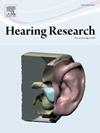利用全外显子组测序揭示婴儿后诊断的感音神经性听力损失的遗传基础
IF 2.5
2区 医学
Q1 AUDIOLOGY & SPEECH-LANGUAGE PATHOLOGY
引用次数: 0
摘要
目的了解中国婴幼儿后诊断的感音神经性听力损失的遗传原因和突变谱。方法纳入2018年11月至2022年10月在复旦大学眼科及耳鼻喉科医院就诊的婴幼儿后诊断为双侧感音神经性听力损失的患者(发病年龄1 ~ 60岁)。采用全外显子组测序(WES)来阐明这些患者的遗传病因。此外,对常见耳聋变异的频率进行回顾性分析,并与以往的研究进行比较。结果146例婴儿期后诊断为感音神经性听力损失的患者行WES检查,其中分子诊断阳性93例,总诊断率为63.7%。在50个耳聋相关基因中共鉴定出107个变异。在确诊患者中,GJB2: c.109G>;A(11.6%)、GJB2: c.235delC(7.2%)、SLC26A4: c.919-2A>;G(5.1%)、MPZL2: c.220C>;T(2.4%)、SLC26A4: c.2168A>;G(2.1%)是5种频率最高的变异。内耳畸形患者的诊断率(100% vs 59.5%, P < 0.05)和18岁前发病患者的诊断率(68.9% vs 48.7%, P < 0.05)显著高于无内耳畸形患者和18岁后发病患者。结论本研究初步勾勒出中国婴幼儿后听力损失患者耳聋相关基因突变谱。我们发现了15种新的致病或可能致病的变异,表明GJB2 c.109G>;A是婴儿期后诊断为听力损失的患者中最常见的变异,而MPZL2变异的患者比例高于预期。我们的研究提供了有效的证据,支持对婴儿期后诊断为听力损失的患者进行后续基因检测。本文章由计算机程序翻译,如有差异,请以英文原文为准。
Unraveling the genetic basis of post-infancy diagnosed sensorineural hearing loss using whole exome sequencing
Objective
To clarify the genetic causes and the mutation spectrum of post-infancy diagnosed sensorineural hearing loss in the Chinese population.
Methods
We enrolled patients with post-infancy diagnosed bilateral sensorineural hearing loss (onset age between 1 and 60 years) at the Eye & ENT Hospital of Fudan University from November 2018 to October 2022. Whole-exome-sequencing (WES) was performed to elucidate the genetic etiology of these patients. Additionally, the frequency of common deafness variants was retrospectively analyzed and compared to previous studies.
Results
In this study, 146 patients with post-infancy diagnosed sensorineural hearing loss received WES, of which 93 patients had a positive molecular diagnosis, with an overall diagnostic rate of 63.7 %. A total of 107 variants across 50 deafness-related genes were identified. Among the diagnosed patients, GJB2: c.109G>A (11.6 %), GJB2: c.235delC (7.2 %), SLC26A4: c.919–2A>G (5.1 %), MPZL2: c.220C>T (2.4 %), and SLC26A4: c.2168A>G (2.1 %) were the five variants with the highest frequency. The diagnostic rate in the patients with inner ear malformations (100 % vs 59.5 %, P < 0.05) and patients with onset before age of 18 years (68.9 % vs 48.7 %, P < 0.05) was significantly higher than in patients without inner ear malformations and with an onset after age of 18 years.
Conclusion
This study has preliminarily outlined the spectrum of gene mutations associated with deafness in patients with post-infancy diagnosed hearing loss within the Chinese population. We identified 15 novel pathogenic or likely pathogenic variants, indicating that the GJB2 c.109G>A is the most common variant in post-infancy diagnosed hearing loss patients, and the proportion of patients with MPZL2 variants is higher than expected. Our study provides valid evidence to support subsequent genetic testing for patients with post-infancy diagnosed hearing loss.
求助全文
通过发布文献求助,成功后即可免费获取论文全文。
去求助
来源期刊

Hearing Research
医学-耳鼻喉科学
CiteScore
5.30
自引率
14.30%
发文量
163
审稿时长
75 days
期刊介绍:
The aim of the journal is to provide a forum for papers concerned with basic peripheral and central auditory mechanisms. Emphasis is on experimental and clinical studies, but theoretical and methodological papers will also be considered. The journal publishes original research papers, review and mini- review articles, rapid communications, method/protocol and perspective articles.
Papers submitted should deal with auditory anatomy, physiology, psychophysics, imaging, modeling and behavioural studies in animals and humans, as well as hearing aids and cochlear implants. Papers dealing with the vestibular system are also considered for publication. Papers on comparative aspects of hearing and on effects of drugs and environmental contaminants on hearing function will also be considered. Clinical papers will be accepted when they contribute to the understanding of normal and pathological hearing functions.
 求助内容:
求助内容: 应助结果提醒方式:
应助结果提醒方式:


